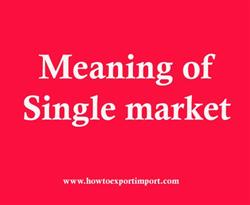What is single market under Indian Tax
The details about single market are explained here.
Single market
A single market is a type of trade bloc in which most trade barriers have been removed (for goods) with some common policies on product regulation, and freedom of movement of the factors of production (capital and labour) and of enterprise and services. The goal is that the movement of capital, labour, goods, and services between the members is as easy as within them. The physical (borders), technical (standards) and fiscal (taxes) barriers among the member states are removed to the maximum extent possible. These barriers obstruct the freedom of movement of the four factors of production.
 A common market is usually referred to as the first stage towards the creation of a single market. It usually is built upon a free trade area with relatively free movement of capital and of services, but not so advanced in reduction of the rest of the trade barriers.
A common market is usually referred to as the first stage towards the creation of a single market. It usually is built upon a free trade area with relatively free movement of capital and of services, but not so advanced in reduction of the rest of the trade barriers.
A unified market is the last stage and ultimate goal of a single market. It requires the total free movement of goods, services (including financial services), capital and people without regard to national boundaries
A common market allows for the free movement of capital and services but large amounts of trade barriers remain. It eliminates all quotas and “tariffs” – duties on imported goods – from trade in goods within it. However “non-tariff barriers” remain such as differences between the Member States’ safety, packaging requirements and national administrative procedures. They prevent for example manufacturers from marketing the same goods in all member states. The objective of a common market is most often economic convergence and the creation of an integrated single market. It is sometimes considered as the first stage of a single market. The European Economic Community was the first example of a common market.
A single market (sometimes called 'internal market') allows for people, goods, services and capital to move around a union as freely as they do within a single country – instead of being obstructed by national borders and barriers as they were in the past. Citizens can study, live, shop, work and retire in any member state. Consumers enjoy a vast array of products from all member states and businesses have unrestricted access to more consumers. A single market is commonly described as "frontier-free". However, several barriers remain such as differences in national tax systems, differences in parts of the services sector and different requirements for e-commerce. In addition separate national markets still exist for financial services, energy and transport. Laws concerning the recognition of professional qualifications also may not be fully harmonized. The Eurasian Economic Union, the Gulf Cooperation Council, CARICOM and the European Union are current examples of single markets, although the GCC's single market has been described as "malfunctioning" in 2014. The European Union is the only economic union whose objective is "completing the single market."
A completed, unified market usually refers to the complete removal of barriers and integration of the remaining national markets. Complete economic integration can be seen within many countries, whether in a single unitary state with a single set of economic rules, or among the members of a strong national federation. For example, the sovereign states of the United States do to some degree have different local economic regulations (e.g. licensing requirements for professionals, rules and pricing for utilities and insurance, consumer safety laws, environmental laws, minimum wage) and taxes, but are subordinate to the federal government on any matte of interstate commerce the national government chooses to assert itself. Movement of people and goods among the states is unrestricted and without tariffs.
This post describes about Single market. Comment below your thoughts about this post Single market.
Learn Exports Imports Free, Click here
Click here to know GST rate of your goods or service
Definition of E-Commerce under GST
TDS under GST, Frequently Asked Questions
Does Interest attract on GST Tax payment delay?
Mechanism of Payment of GST tax in India
Levy of late fee for GST Tax returns filing in India
Notice to GST return filing defaulters
When to file Annual Return of GST online?
Procedures to claim reduction in output tax liability of GST in India
Procedures to claim Input Tax Credit under GST in India
When to file first Return of GST tax in India?
GST Tax returns filing – Who, How and When?
How is time of supply accounted under GST Tax Calculation
Valuation of GST under special cases
What is apportionment of tax and settlement of funds under GST
What is Settlement Commission under GST
Term Separate registration for multiple business under GST
Meaning of term Self Assessed Tax under GST
What is Scrutiny of returns under GST
Meaning of GST Practitioner
Term Revenue neutral rate (RNR) under GST
Term Revocation of cancellation of registration under GST
Procedure to claim Duty Drawback
Procedures and documentation on Triangular shipments
Procedures for Re-imports
Procedures to claim brand rate of draw back
Procedures to file IGM (Import General Manifest)
Procedures under Re-exports
Re warehousing procedures under STP and EOU units.
Register with Export Promotion Council
Risks and solutions in export business
RISKS NOT COVERED BY MARINE INSURANCE
How to export from India to Lesotho?
Documents required for Export from Lesotho
Customs procedures for Lesotho Export
Registration required to export from Lesotho
Documents needed for Lesotho import
Import Customs processes in Lesotho
Import Registration and import Licence procedures in Lesotho
How to export from Equatorial Guinea?
How to Import to Equatorial Guinea?